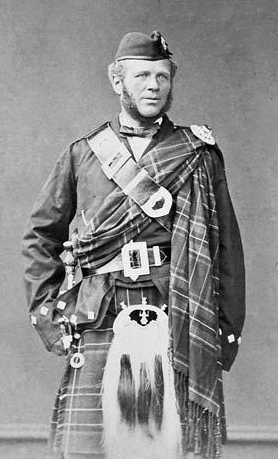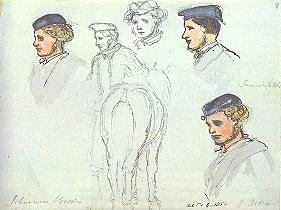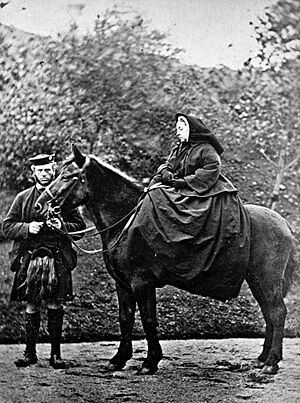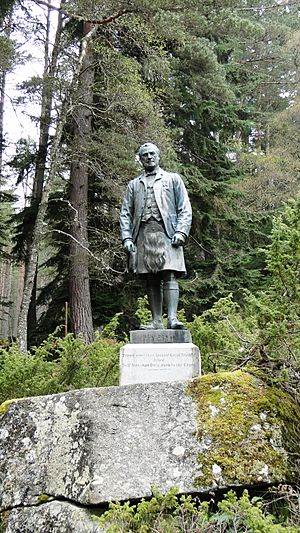John Brown (servant) facts for kids
Quick facts for kids
John Brown
|
|
|---|---|

Brown, c. 1860s
|
|
| Born | 8 December 1826 Crathie, Aberdeenshire, Scotland
|
| Died | 27 March 1883 (aged 56) Windsor Castle, England
|
| Resting place | Crathie Kirk, Aberdeenshire, Scotland |
| Occupation | Ghillie & Personal Attendant |
| Employer | Victoria, Queen of the United Kingdom |
John Brown (born 8 December 1826 – died 27 March 1883) was a Scottish man who became a close friend and personal helper to Queen Victoria. He first worked for her husband, Prince Albert, as a ghillie (an outdoor servant).
Many people, including the Queen, liked John Brown for his helpfulness and friendship. However, others, like the Queen's children and palace staff, didn't like his strong influence and casual way of speaking to the Queen. People at the time wondered a lot about how close his relationship with Queen Victoria really was.
Contents
John Brown's Early Life
John Brown was born on 8 December 1826 in Crathienaird, a place in Aberdeenshire, Scotland. His parents were Margaret Leys and John Brown.
He started working as an outdoor servant, or ghillie, at Balmoral Castle. Queen Victoria and Prince Albert first rented Balmoral Castle in 1848. Later, they bought it in 1851.
John Brown had several younger brothers and a sister. Three of his brothers also worked for the royal family. His brother, Archibald Anderson "Archie" Brown, became a personal helper to Queen Victoria's youngest son, Prince Leopold, Duke of Albany.
His Special Friendship with Queen Victoria
By 1851, John Brown's job changed. He stopped being just a ghillie and became the main person in charge of the Queen's pony. Prince Albert himself suggested this change.
When Prince Albert died suddenly in 1861, Queen Victoria was very sad. She never fully got over his death. John Brown became a good friend and supported the Queen during this difficult time.
Queen Victoria gave John Brown many gifts. She even created two special medals just for him: the Faithful Servant Medal and the Devoted Service Medal. In 1876, she asked an artist to paint his picture. She gave him this portrait on Prince Albert's birthday.
Queen Victoria's children and her government ministers did not like how close she was to John Brown. Some people even started rumors that their relationship was not proper. Queen Victoria said these were just "ill-natured gossip" from high-society people.
A letter from Queen Victoria, found in 2004, showed how much she missed John Brown after he died. She wrote:
"Perhaps never in history was there so strong and true a friendship, so warm and loving a friendship between the Queen and her servant ... Strong in character, brave, honest, kind, fair, independent, and unselfish, with a tender, warm heart ... he was one of the most amazing men. The Queen feels that life for the second time is very hard and sad to bear, without all she needs ... the loss is too heavy not to be felt very much..."
When Queen Victoria wrote "for the second time," she meant that John Brown's death felt as sad as the death of her husband, Prince Albert. The historian who found this letter thought it meant Queen Victoria saw John Brown as more than just a servant. She saw him as a very good friend and someone she could trust. However, there is no proof that John Brown and Queen Victoria were romantic partners.
After John Brown died, Queen Victoria became close to another servant, Mohammed Abdul Karim, who was from India. She called him the Munshi. People disliked him even more than they disliked John Brown.
Queen Victoria had very specific instructions for her burial. She wanted certain items placed in her coffin with her. Along with Prince Albert's dressing gown and a plaster cast of his hand, she was buried with a lock of John Brown's hair, his photograph, and his mother's wedding ring (which he had given to her). The photograph was placed in her left hand, hidden by flowers. She wore the ring on her right hand.
John Brown's Death
John Brown became very ill with a skin infection called erysipelas. He could not attend the Queen for the first time in over eighteen years. He died two days later, on 27 March 1883, at Windsor Castle. He was 56 years old.
John Brown is buried in Crathie Kirkyard, Scotland, next to his parents and some of his brothers and sisters. The words on his gravestone show how much Queen Victoria cared for him:
"This stone is put up in loving and thankful memory of John Brown, the devoted and faithful personal helper and beloved friend of Queen Victoria. He served her for 34 years.
Born at Crathienaird 8th Decr. 1826 died at Windsor Castle 27th March 1883.
That Friend on whose loyalty you count/that Friend given to you by life’s events/over which you have no control/was God’s own gift.
Well done good and faithful servant/You have been faithful over a few things,/I will make you ruler over many things/Enter into the joy of the Lord."
Queen Victoria wrote to John Brown's sister-in-law, Jessie McHardy Brown, saying, "He was the best, truest heart that ever beat." She also asked the poet Alfred Tennyson to write some lines for Brown's tombstone. Victoria praised her loyal servant, saying:
He had no thought but for me, my well-being, my comfort, my safety, my happiness. Brave, unselfish, completely fair, very discreet, always speaking the truth and telling me what he thought was "just and right," without flattery and without saying what would be pleasing if he didn't think it was right. . . . The comfort of my daily life is gone—the emptiness is terrible—the loss cannot be fixed!
Soon after John Brown's death, Queen Victoria asked artist Edgar Boehm to create a life-sized statue of him. The statue had these words carved on it: Friend more than Servant. Loyal. Truthful. Brave. Self less than Duty, even to the Grave.
When Queen Victoria's son, Edward VII, became king, he had the statue moved to a less noticeable spot. Edward VII and John Brown had often argued, and Edward did not like Brown. Edward VII also ordered that other statues and private memorials Victoria made for Brown be destroyed.
Awards and Recognition
John Brown received special awards from Queen Victoria:
- Victoria Devoted Service Medal (a gold medal). On the back, it says, To John Brown, Esq., for his quick thinking and loyalty at Buckingham Palace, February 29, 1872.
- Faithful Servant Medal (a silver medal). It had a bar to show he served for ten more years.
Queen Victoria herself asked for both of these medals to be designed and made.
- A silver medal (possibly a Servant medal?), showing the head of Louis III, Grand Duke of Hesse.




